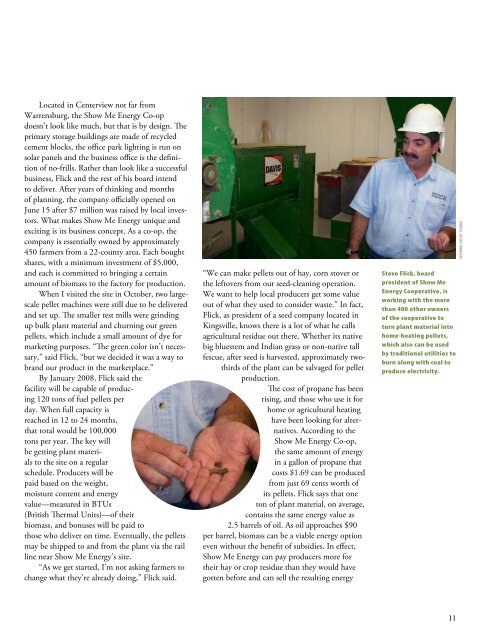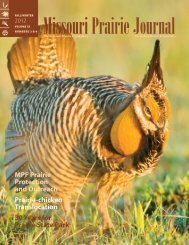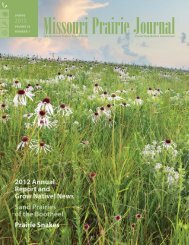Fall 2007: Volume 28, Number 4 - Missouri Prairie Foundation
Fall 2007: Volume 28, Number 4 - Missouri Prairie Foundation
Fall 2007: Volume 28, Number 4 - Missouri Prairie Foundation
You also want an ePaper? Increase the reach of your titles
YUMPU automatically turns print PDFs into web optimized ePapers that Google loves.
Located in Centerview not far fromWarrensburg, the Show Me Energy Co-opdoesn’t look like much, but that is by design. Theprimary storage buildings are made of recycledcement blocks, the office park lighting is run onsolar panels and the business office is the definitionof no-frills. Rather than look like a successfulbusiness, Flick and the rest of his board intendto deliver. After years of thinking and monthsof planning, the company officially opened onJune 15 after $7 million was raised by local investors.What makes Show Me Energy unique andexciting is its business concept. As a co-op, thecompany is essentially owned by approximately450 farmers from a 22-county area. Each boughtshares, with a minimum investment of $5,000,and each is committed to bringing a certainamount of biomass to the factory for production.When I visited the site in October, two largescalepellet machines were still due to be deliveredand set up. The smaller test mills were grindingup bulk plant material and churning out greenpellets, which include a small amount of dye formarketing purposes. “The green color isn’t necessary,”said Flick, “but we decided it was a way tobrand our product in the marketplace.”By January 2008, Flick said thefacility will be capable of producing120 tons of fuel pellets perday. When full capacity isreached in 12 to 24 months,that total would be 100,000tons per year. The key willbe getting plant materialsto the site on a regularschedule. Producers will bepaid based on the weight,moisture content and energyvalue—measured in BTUs(British Thermal Units)—of theirbiomass, and bonuses will be paid tothose who deliver on time. Eventually, the pelletsmay be shipped to and from the plant via the railline near Show Me Energy’s site.“As we get started, I’m not asking farmers tochange what they’re already doing,” Flick said.“We can make pellets out of hay, corn stover orthe leftovers from our seed-cleaning operation.We want to help local producers get some valueout of what they used to consider waste.” In fact,Flick, as president of a seed company located inKingsville, knows there is a lot of what he callsagricultural residue out there. Whether its nativebig bluestem and Indian grass or non-native tallfescue, after seed is harvested, approximately twothirdsof the plant can be salvaged for pelletproduction.The cost of propane has beenrising, and those who use it forhome or agricultural heatinghave been looking for alternatives.According to theShow Me Energy Co-op,the same amount of energyin a gallon of propane thatcosts $1.69 can be producedfrom just 69 cents worth ofits pellets. Flick says that oneton of plant material, on average,contains the same energy value as2.5 barrels of oil. As oil approaches $90per barrel, biomass can be a viable energy optioneven without the benefit of subsidies. In effect,Show Me Energy can pay producers more fortheir hay or crop residue than they would havegotten before and can sell the resulting energySteve Flick, boardpresident of Show MeEnergy Cooperative, isworking with the morethan 400 other ownersof the cooperative toturn plant material intohome-heating pellets,which also can be usedby traditional utilities toburn along with coal toproduce electricity.Photos Justin Johnson11
















